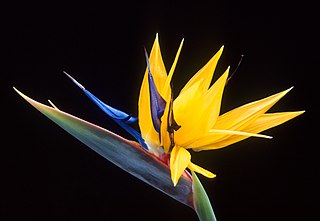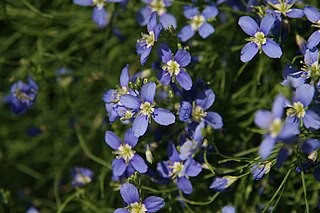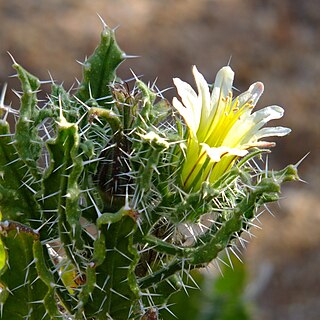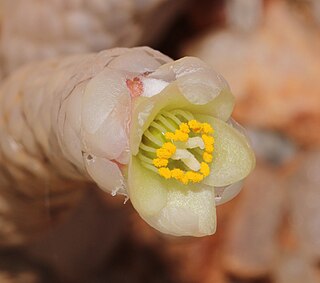
Strelitzia is a genus of five species of perennial plants, native to South Africa. It belongs to the plant family Strelitziaceae. A common name of the genus is bird of paradise flower/plant, because of a resemblance of its flowers to birds-of-paradise. In South Africa, it is commonly known as a crane flower.

Acanthospermum is a genus of plants in the family Asteraceae, also known as starburrs or starburs. It was described as a genus in 1820.

Cyrtanthus obliquus, the Knysna lily, is a species of plant in the amaryllis family with spiraling leaves and large pendulous flowers. It is native to coastal grassland from KwaZulu-Natal to the Eastern Cape, South Africa.

Euphorbia mauritanica, commonly known as yellow milk bush or golden spurge, is a species of plant in the family Euphorbiaceae native to Africa.

Coleus madagascariensis, synonym Plectranthus madagascariensis, called thicket coleus, Madagascar coleus and candle plant, is a species of flowering plant in the family Lamiaceae. It is native to South Africa, eSwatini, Mozambique, Mauritius and Réunion, but not Madagascar. Its cultivar 'Variegated Mintleaf' has gained the Royal Horticultural Society's Award of Garden Merit.
Didymaotus is a monotypic genus of flowering plant belonging to the family Aizoaceae, containing the single species Didymaotus lapidiformis. The plant is also known by the names stone plant and beeskloutjie. It occurs natively in the arid regions of Tanqua Karoo, near Ceres in the Western Cape. The generic name is taken from the Greek words didymos, meaning double, and aotus, meaning flower; the plant that bears two flowers. The specific epithet lapidiformis means stone-like, as it is not easily seen, blending in with its surroundings.

Dalechampia capensis is a species of shrub. It is known by the common names inzula or wild hop.

Serruria glomerata, the cluster spiderhead, is a flower-bearing shrub that belongs to the genus Serruria and forms part of the fynbos. The plant is native to the Western Cape, it occurs on the Cape Flats and Cape Peninsula. The shrub is erect and grows only 40 cm tall and bears flowers from August to October.

Serruria villosa, the golden spiderhead, is a flower-bearing shrub that belongs to the genus Serruria and forms part of the fynbos. The plant is native to the Western Cape, where it occurs only on the Cape Peninsula and just south of Constantia. The shrub is erect and grows only 50 cm tall and bears flowers from April to July.

Paranomus spathulatus, the Langeberg sceptre, is a flower-bearing shrub that belongs to the genus Paranomus and forms part of the fynbos. The plant is native to the Western Cape, South Africa.
Paranomus candicans, the powder sceptre, is a flower-bearing shrub that belongs to the genus Paranomus and forms part of the fynbos. The plant is native to the Western Cape, South Africa.

Haworthia pubescens is a perennial succulent belonging to the genus Haworthia and is part of the fynbos. The species is native to the Western Cape and is found in Worcester. The plant has an occurrence area of less than 10 km2 and there is one subpopulation that is threatened by infrastructure development for agriculture as well as by invasive plants.

Heliophila coronopifolia is a species of flowering plant in the genus Heliophila. It is native to the Northern Cape and Western Cape provinces of South Africa.

Oxalis obtusa is a species of flowering plant in the genus Oxalis. It is native to the Cape Provinces, and KwaZulu-Natal in South Africa.

Codon royenii is a species of flowering plant in the genus Codon. It is native to Namibia and the Northern Cape Province of South Africa. It is also known by the names honey bush or white nectarcup, or in Afrikaans as heuningbos and suikerkelk.

Psoralea cataracta is a species of flowering plant in the genus Psoralea. It was declared extinct in 2008 in the Red Data List of South African Plants, with a single specimen collected from the Tulbagh Waterfall in 1804. It was rediscovered 200 years later by Brian Du Preez in November of 2019 in the Winterhoek Mountains near Tulbagh. It is endemic to the Western Cape. It is also known by the name waterfall fountainbush.

Kissenia capensis is a species of flowering plant in the genus Kissenia. It is native to Namibia and the Northern Cape Province of South Africa.

Anacampseros papyracea is a species of succulent plant in the genus Anacampseros. It is endemic to Southern Africa.

Delosperma lehmannii is a succulent plant native to parts of the Eastern Cape Province of South Africa. Sometimes called ice plant, it is grown as a decorative houseplant for its distinctive smooth, angular leaves. The specific epithet lehmannii honors the German professor of botany in Hamburg Johann Georg Christian Lehmann.
Juncus capillaceus is a rush species native to South America, but has been introduced to other parts of the world.

















